Abstract
Ground deformation is usually used as direct evidence for early warning of geological hazards. The Weihe Graben, located in the southern margin of the Ordos Plateau, is surrounded by many active faults. Earthquakes (e.g., the 1556 Huaxian M 8 earthquake), mine accidents and ground fissures are the major hazards that pose great threats to this densely populated region. In order to characterise both tectonic and anthropogenic activities in the Weihe Graben, we use Envisat data from 2003 to 2010 and Sentinel-1 data from 2014 to 2021, combined with levelling data from 1970 to 2014, to investigate the long-term ground deformation. We generate four InSAR rate maps using the small-baseline subset (SBAS) algorithm. The uncertainties of the InSAR rates are 1–2 mm/year by calculating the differences between the InSAR and levelling measurements. From the deformation time series, we found that most of the faults surrounding the Weihe Graben move at a relatively slow rate (<3 mm/year). Elastic dislocation modelling based on the InSAR and levelling data yields a slip rate of 2.3 ± 0.3 mm/year for the Huashan Fault, the seismogenic fault for the 1556 Huaxian earthquake. Anthropogenic deformation is much stronger than the tectonic deformation. We identified localised subsidence of 12 mines with a deformation rate ranging from 5 to 17 mm/year. The cities of Xi’an and Xianyang also show evident subsidence, which is likely to be caused by groundwater extraction. Land subsidence in Xi’an has slowed down from an average rate of 10–20 mm/year between 2003 and 2010 to about 5–10 mm/year between 2017 and 2020, but in Xianyang, subsidence has increased dramatically in the past five years from 1 mm/year to 7 mm/year. This is because new industrial and urban development centres have gradually moved from Xi’an to Xianyang. We identified a region bounded by the Kouzhen-Guanshan and Fufeng-Liquan Faults with strong subsidence, as a result of excessive extraction of groundwater. To quantify the effects of crustal groundwater unloading on faults, we calculated the static Coulomb stress changes on the two faults and found that Coulomb stress changes are localised in the upper 5 km with a magnitude of 0.01–0.02 bar/year. The Coulomb stress changes might be large enough (0.1 bar) to affect local seismicity if such excessive extraction of groundwater continued for 10 years.
1. Introduction
The graben of the river Wei, the Weihe Graben (Figure 1), in Shaanxi Province, is the southern margin of the Ordos Plateau that has been a stable block since the Mesozoic [1,2]. It is a seismically active region, where the deadliest earthquake in history, the 1556 M 8 Huaxian earthquake, occurred, having resulted in an estimated death toll of ∼830,000 from building collapse, land-sliding, famine and disease [3,4]. The graben is surrounded by active faults: to the north, it is bounded by a series of normal faults, including the Kouzhan-Guanshan and Beishan Faults; to the south, it is bounded by the North Qinling (southwest) and Huashan (southeast) Faults; the Weihe Fault transects the graben; the Liupanshan Fault forms the western boundary. All these faults have hosted large earthquakes since the Quaternary, as confirmed by historical earthquake records and palaeoseismological data (e.g., [1,3,4,5,6]), posing a serious seismic hazard to this densely populated region. The distribution and style of active faults are crucial for assessing such hazard. Recent studies have measured the rate of active faulting in the graben using geomorphological and geological dating techniques: the Kouzhen-Guanshan, Beishan and Weihe Faults have a vertical slip rate of 0.5–1.1 mm/year [5]; the Weinan and Huashan Faults have a vertical slip rate of 1–3 mm/year [4,6]; the Liupanshan Fault has an uplift rate of 1–3 mm/year [7]. So far, there are a limited number of geodetic observations to verify these geological measurements.
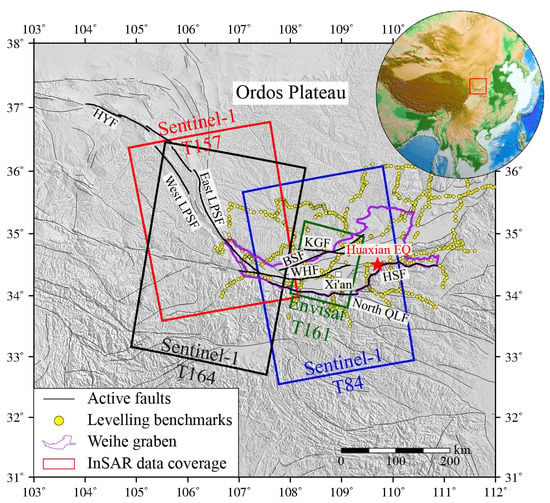
Figure 1.
Study area. Polygons mark the coverage of each InSAR track. Yellow filled circles indicate the locations of the levelling benchmarks. Black lines are active faults, from [8]. HYF: Haiyuan Fault. East LPSF: East Liupanshan Fault. West LPSF: West Liupanshan Fault. BSF: Beishan Fault. KGF: Kouzhen-Guanshan Fault. WHF: Weihe Fault. North QLF: North Qinling Fault. HSF: Huashan Fault. The red star denotes the epicentre of the 1556 Huaxian earthquake.
Apart from the extensive ongoing tectonic deformation, the graben has also been experiencing anthropogenic deformation. As pointed out in earlier studies [9,10], Xi’an, a metropolitan city located in the graben with a population of over 10 million, has suffered severe land subsidence with an average rate of 50 mm/year during 2005–2012, as a result of groundwater pumping. The metropolitan area has expanded extensively in the past five years. For example, the city of Xianyang to the north of Xi’an became the new development centre. The aim of this study is to investigate ground deformation surrounding the Weihe Graben on decadal timescales, using radar interferometry (InSAR) and levelling data. We are interested in the land processes associated with this rapid urbanisation at larger spatial and temporal scales. To reach our goal of characterising both tectonic and anthropogenic deformation, we use Envisat data from 2003 to 2010 and Sentinel-1 data from 2014 to 2021, in combination with levelling data from 1970 to 2014, to map displacement time series.
The interactions between tectonic and anthropogenic activities are also discussed in this study. With rapid urbanisation and excessive extraction of groundwater, significant subsidence (ranging from 1 cm/year to tens of cm/year) has been observed in many cities in the world, which has been confirmed to be responsible for various geohazards such as surface fractures and earthquakes (e.g., [11,12,13,14]). Based on ALOS InSAR time series, Chaussard et al. (2014) [15] observed that the ground subsidence rate in Mexico exceeded 30 cm/year from 2007 to 2011. The large rate gradient boundaries were consistent with surface fractures. Recently, Cigna et al. (2021) obtained a maximum urban subsidence rate of 39 cm/year in Mexico from 2014 to 2020 by using Sentinel-1 data and evaluated the fracture risk around the subsiding area [16]. Through mapping land subsidence and calculating the associated Coulomb stress changes [17], González et al. (2011) found that the 2011 5.1 Lorca earthquake was triggered by groundwater extraction. The Weihe Graben, a well-known tectonically active region with intense anthropogenic activities, is an ideal laboratory for exploring such interactions. We quantify land-subsidence induced Coulomb stress changes on faults in the graben, providing important information about seismic hazard assessment.
2. Data and Methods
2.1. Envisat Data in 2003–2010
A total of 16 Envisat ASAR images were acquired between 2003 and 2010 from descending track 161 across the central part of the Weihe Graben (Figure 1). Interferograms were produced using the GAMMA software package. We removed the topographic phase using the 30 m resolution Shuttle Radar Topography Mission (SRTM) DEM [18]. Each interferogram was multilooked with a factor of 5 in range and 25 in azimuth. We manually selected 39 interferograms for the subsequent time-series analysis (Figure 2a), for which we used the small baseline subset algorithm (SBAS) implemented in the Stanford Method for Persistent Scatterers (StaMPS) [19,20]. Furthermore, 0.6 was used as the threshold of amplitude difference dispersion in order to select candidate Slow-varying Filtered Phase (SFP) pixels. We adopted the 3-D unwrapping method [19,20] to solve for the true phase difference between the SFPs. We corrected for the topographically-correlated atmospheric errors using the Toolbox for Reducing Atmospheric InSAR Noise (TRAIN) [21]. Residual DEM and orbital errors can be determined and removed by estimating the spatially-correlated look angle errors. The workflow of InSAR data processing is summarised in Figure 3. The resulting interferograms were used to calculate the line-of-sight (LOS) displacement time series between 2003 and 2010 (Figure 4a).
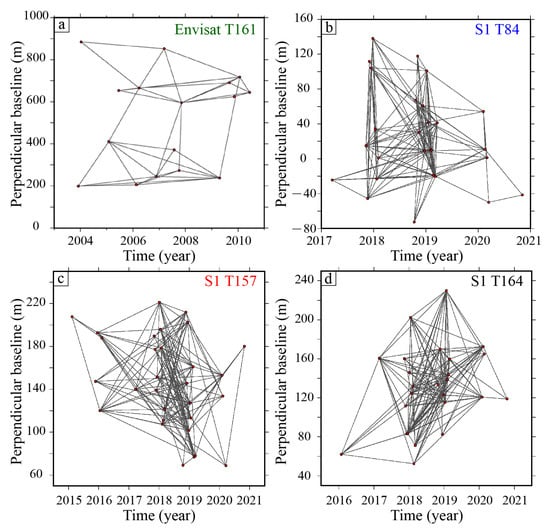
Figure 2.
Baseline plots of selected small baseline interferograms from one Envisat track ((a) T161) and three Sentinel-1 tracks ((b) T84, (c) T157 and (d) T164). Red dots are selected SAR acquisitions: 16 from T161, 27 from T84, 30 from T157 and 25 from T164. Lines are the interferograms used in our time-series analysis.
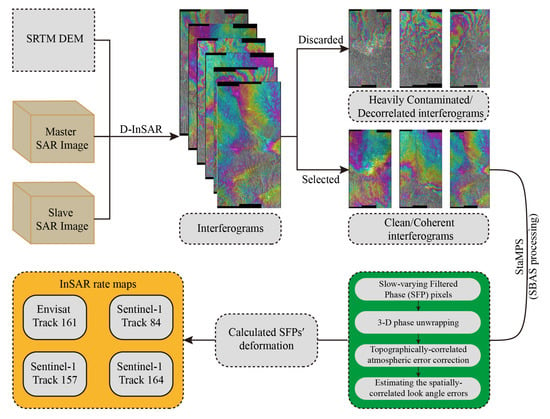
Figure 3.
Flowchart of InSAR data processing.
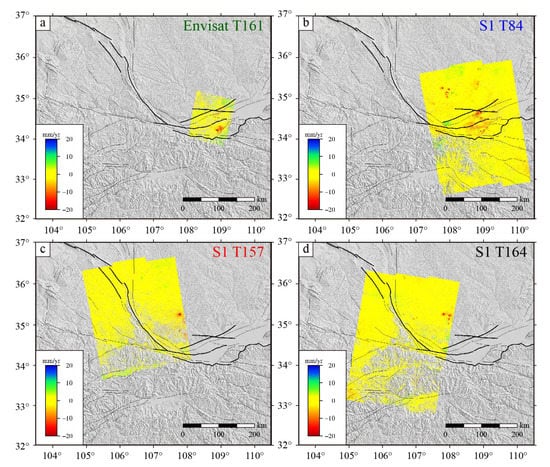
Figure 4.
InSAR rate maps from (a) Envisat track (T161) and Sentinel-1 tracks (b) T84, (c) T157 and (d) T164.
2.2. Sentinel-1 Data in 2014–2021
The Sentinel-1 data set covers the southwestern margin of the Ordos Plateau and the Weihe Graben (Figure 1). It consists of 82 images from two ascending tracks (27 from track 84 and 30 from track 157) and one descending track (25 from track 164). We first generated interferograms using GAMMA. To improve the signal-to-noise ratio, we multilooked the interferograms with a factor of 20 in range and 4 in azimuth. We noted that the interferograms in the summer and autumn seasons (March to October) were either heavily contaminated by atmospheric errors or strongly decorrelated due to vegetation, as shown in Figure 5a,c,e. We therefore only selected SAR acquisitions between November and the following February to form interferograms (Figure 2b–d) and obtained a total of 143 interferograms from track 84, 136 from track 157 and 146 from track 164. We used StaMPS for time-series analysis, in which Generic Atmospheric Correction Online Service for InSAR (GACOS) [22] was used for atmospheric corrections. The rate maps are shown in Figure 4b–d.
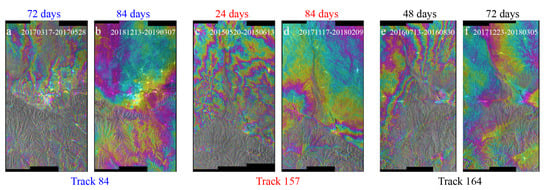
Figure 5.
Examples of discarded (a,c,e) and selected (b,d,f) interferograms.
2.3. Levelling Data in 1970–2014
Most of the levelling data (1970–2014) used in this study are taken from [23]. Their data sources include the network of levelling benchmarks used for seismic applications across major active faults in China (surveyed by the China Earthquake Administration, CEA) and the national levelling network of China (organised by the National Administration of Surveying, Mapping and Geoinformation, NASMG). We also acquired additional 600 km levelling routes in the Weihe Graben collected by NASMG in 2013. These levelling routes were surveyed in the first-order levelling. In order to define the vertical reference frame and reduce the systematic errors accumulated over hundreds of kilometres, we used the vertical rates of 5 continuous Global Positioning System (GPS) stations within the study area as the a priori constraints (Hao et al., 2016). The misclosures computed from forward and backward levelling of the seismic networks are within ±0.4 mm/km and within ±0.5 mm/km and ±1.0 mm/km for the first-order and second-order levelling of the national levelling network, respectively [23]. Locations of the levelling benchmarks (760 in total) are shown in Figure 1.
3. Results
Figure 4 shows the rate maps derived from Envisat and Sentinel-1 data. To quantify the uncertainties of the InSAR rates, we calculated the differences between the InSAR and levelling measurements. Using the incidence angles of each InSAR track, the vertical rates from levelling were converted to the line-of-sight (LOS) direction. The differences between the InSAR and levelling data are (Figure 6): 0.4 ± 2.6 mm/year for Envisat T161, 1.5 ± 1.3 mm/year for Sentinel-1 T84, 1.3 ± 2.2 mm/year for Sentinel-1 T157 and 0.9 ± 1.4 mm/year for Sentinel-1 T164. The uncertainties are consistent with the intrinsic accuracy (1–2 mm/year) of InSAR measurements.
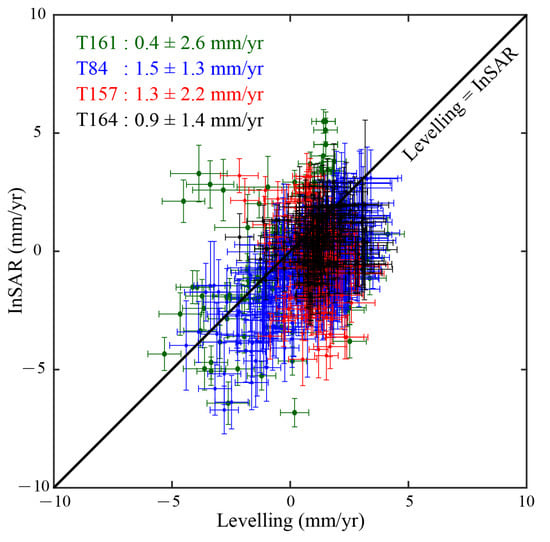
Figure 6.
Comparing InSAR rates with levelling data. The mean difference and its standard deviation are: 0.4 ± 2.6 mm/year (T161), 1.5 ± 1.3 mm/year (T84), 1.3 ± 2.2 mm/year (T157) and 0.9 ± 1.4 mm/year (T164).
At first sight, we did not observe significant deformation gradients across any of the faults, as we would see from fast-moving faults such as the Altyn Tagh [24] and Xianshuihe [25] Faults, indicating that the faults in the Weihe Graben move at a slow rate (<3 mm/year). Swath profiles were extracted to analyse the tectonic deformation in Section 4.1.
A number of localised deformation signals are evident in the InSAR rate maps (Figure 4). We see subsidence (up to 15 mm/year) within the Ordos Plateau, one of the main coal-producing areas in China. The ongoing mining may change the stability of subsurface, leading to sudden collapse. We show the subsidence time series in Section 4.2. Besides mining-induced subsidence, we also find other deformation signals. From the Sentinel-1 T84 rate map, a region bounded by the Kouzhen-Guanshan (KGF) and Fufeng-Liquan (FLF) Faults shows significant subsidence (Figure 4b). This signal, an average rate of >10 mm/year, is unlikely to be tectonic deformation which should be less than 3 mm/year. The possible cause is groundwater extraction for agricultural purposes. This is commonly seen in fault-bounded basins as faults can control groundwater flow [26]. Such extensive land subsidence occurs so close to seismogenic faults that it might affect their state of stress. We quantify this effect in Section 4.4.
4. Discussion
4.1. Tectonic Deformation Surrounding the Weihe Graben
We extracted swath profiles (50 km wide, 150 km long) across the major faults around the Weihe Graben in order to quantify fault motion (Figure 7). The LOS rates are relatively flat, without evident gradients across the Haiyuan and Liupanshan Faults (Figure 7b–d). The motion of the Haiyuan Fault (left-lateral strike-slip) is nearly parallel to the flight direction, so although the Haiyuan Fault moves at a rate of 5–7 mm/year [27], it is difficult to see from our InSAR profiles. The shortening and uplift of the Liupanshan Fault are not restricted by the LOS directions, but the profiles do not show convincing tectonic signals, implying that the slip rate of the Liupanshan Fault is small, possibly less than 2 mm/year. For profiles DD’ and EE’, where we have relatively dense levelling data, we see deformation signals across the North Qinling, Beishan and Huashan Faults. We attempted to combine the InSAR and levelling (converted from vertical to satellite LOS) rates to invert for fault slip using an elastic dislocation on dip-slip faults [28]. The LOS rate at a given surface point () is related to fault slip at depth via:
where v is the tectonic loading rate, is the fault dip angle, is the satellite incidence angle, is the distance from the dislocation scaled by the locking depth (d) of the fault and is the total length on both sides of the fault from the surface trace position ().

Figure 7.
Swath profiles across major active faults surrounding the Weihe Graben. (a) Rate map from Sentinel-1 data. (b) Swath profile AA’. (c) Swath profile BB’. (d) Swath profile CC’. (e) Swath profile DD’. (f) Swath profile EE’. Coloured dots in (b–f) are InSAR measurements from different tracks, with coloured solid lines indicating the corresponding average value. Red points with error bars in (e,f) are levelling data (1- error). Green lines are the best-fitting elastic dislocation models (see Section 4.1 for details). HYF: Haiyuan Fault. East LPSF: East Liupanshan Fault. West LPSF: West Liupanshan Fault. BSF: Beishan Fault. KGF: Kouzhen-Guanshan Fault. WHF: Weihe Fault. North QLF: North Qinling Fault. HSF: Huashan Fault.
In the inversions, we fixed the geometry of the faults: for the North Qinling Fault, the dip and locking depth are 75° and 10 km; for the Beishan Fault, the dip and locking depth are 50° and 10 km; and for the Huashan Fault, the dip and locking depth are 75° and 10 km. We implemented the Monte Carlo sampler to determine the slip on each of the faults. The sampler ran 100,000 iterations from which we estimated the maximum a posteriori probability solution and the corresponding parameter uncertainties. The Monte Carlo simulations yield a best-fit slip rate of 6.4 ± 0.7 mm/year for the North Qinling Fault, 3.7 ± 0.5 mm/year for the Beishan Fault and 2.3 ± 0.3 mm/year for the Huashan Fault. Although the models fit the profiles well (Figure 7e,f), the modelled slip rates for the North Qinling and Beishan Faults are unreasonably large. This is because a significant fraction of the observed deformation is land subsidence caused by anthropogenic activities, rather than tectonic deformation. The profile across the Huashan Fault is less contaminated by anthropogenic deformation and gave a reasonable estimate of slip rate, 2.3 mm/year, which conforms to the geological estimate (1.67–2.71 mm/year in the Holocene) [29]. Given a characteristic slip of 8–10 m in the 1556 Huaxian earthquake [4], the recurrence interval of M 8 earthquakes would be 3.5–4.3 kyear.
4.2. Mining-Induced Ground Deformation
Ground deformation from InSAR provides important information for mining-induced damage assessment and has been widely used to monitor mining processes [30,31]. In this study, we mapped 12 mines with distinct deformation signals, labelled from K1 to K12 in Figure 8. Because the LOS directions of the ascending and descending tracks differ, the LOS displacement rates from different tracks show some inconsistencies. Maximum subsidence (over 17 mm/year) occurs in the counties of Changwu (K1) and Bin (K2) in the northwestern corner of Xianyang. The other six coal mines in Changwu (K3 and K5) and Bin (K4, K6, K7, and K8) also exhibit large ground subsidence, around ∼10 mm/year. Four coal mines in Ningxia (K9) and Gansu (K10, K11 and K12) show moderate subsidence at a rate of 5–10 mm/year. Although the subsidence rate is marginally smaller than that in many other mining areas, e.g., 125 mm/year in Yu County, China [31], long-term monitoring is still necessary in order to avoid potential damage caused by excessive ground subsidence.
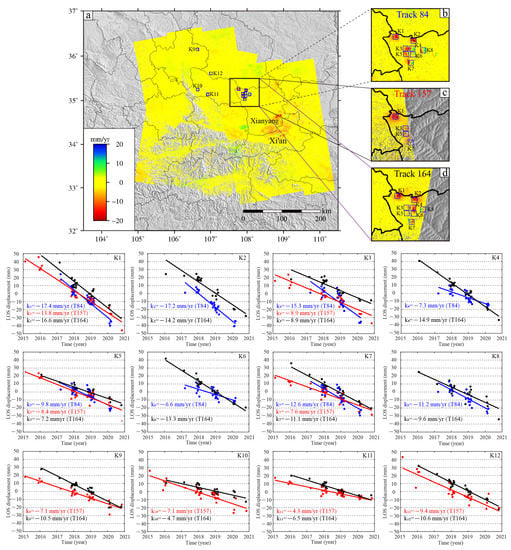
Figure 8.
Time series of mining-induced subsidence. (a–d) show the locations of mines, labelled from K1 to K12. Bottom panels are the displacement time series.
4.3. Decades of Land Subsidence in Major Cities
Xi’an and Xianyang have expanded tremendously in recent years, causing extensive land modifications. Time-series deformation in Figure 9 shows decades of land subsidence, mostly induced by groundwater extraction, in various districts in the two major cities. In general, subsidence in Xi’an has slowed down, from an average LOS rate of 10–20 mm/year between 2003 and 2010 to about 5–10 mm/year between 2017 and 2020, notably in the northern Yanta District (YT1 and YT2). This is because the city of Xi’an started groundwater recharge in 2014, and the policy has effectively controlled land subsidence. Nonetheless, subsidence in Xianyang has increased dramatically in the past five years, from 1 mm/year to 7 mm/year, a subsidence rate comparable to that of Shanghai [32]. The city of Xianyang, where several large infrastructure projects such as the Xi’an Xianyang International Airport were located, has now become the new development centre of the metropolitan area within the Weihe Graben. Land subsidence is an inevitable effect of rapid urbanisation and excessive extraction of groundwater, but attention needs to be paid to the potential geological hazards such as ground fissures, given that the subsurface is mainly composed of unconsolidated loess.
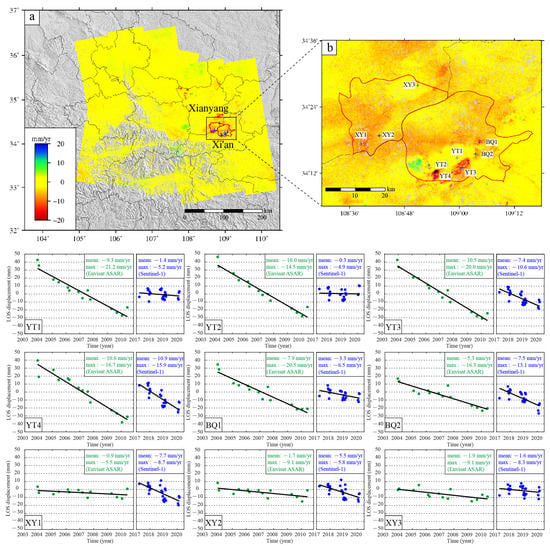
Figure 9.
Time series of subsidence around Xi’an and Xianyang. Mean rate is the long-term average, and max is the maximum annual rate. (a) Rate map from Sentinel-1 data. (b) Land subsidence around Xi’an and Xianyang.
4.4. Subsidence-Induced Coulomb Stress Changes on Nearby Faults
Seismicity induced by human activities is a critical point of discussion [17,33,34,35,36]. From the InSAR rate map (Figure 10), we find large subsidence, >10 mm/year, within the region bounded by the Kouzhen-Guanshan (KGF) and Fufeng-Liquan (FLF) Faults, as a result of groundwater pumping. This will alter regional subsurface stresses and therefore may induce seismicity [17]. To evaluate such influence, we calculate the Coulomb stress changes, induced by crustal groundwater unloading on the two faults. We use Boussinesq’s analytical solution of the 3D elastostatic loading [37,38]. In the Cartesian coordinate system, a point on the fault plane () will be deformed by due to changes in the vertical load at a given surface point () (note that groundwater extraction occurs at depths of tens of metres, but we approximate it as surface process, i.e., , given the much longer distance between the faults):
where R is the distance between the point on the fault plane and the given surface point:
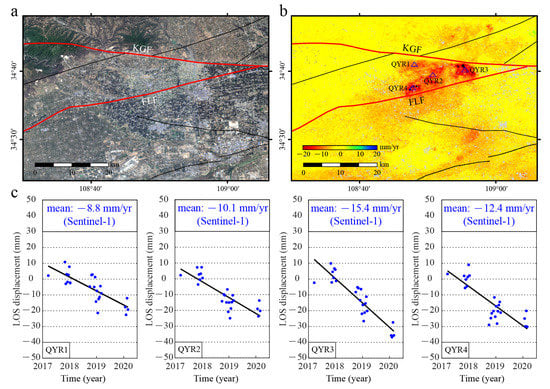
Figure 10.
Land subsidence induced by excessive extraction of groundwater. (a) Google Earth image shows the subsiding region. (b) Rate map. (c) Displacement time series. The maximum subsidence rate (LOS) reaches 15 mm/year. KGF: Kouzhen-Guanshan Fault. FLF: Fufeng-Liquan Fault.
Groundwater extraction is difficult to quantify because the aquifer system is unknown. Although InSAR-derived subsidence can be used to model aquifer system deformation, e.g., [34,39,40], it is beyond the scope of this study. Here, we simply used the empirical ratio (1/27) of the land subsidence to the decrease of the groundwater head [41,42] to convert InSAR-derived subsidence () to the amount of water that have been extracted at depths. A similar ratio (∼1/20) was found in [10]. This may be a biased estimate of the actual , but it provides useful information about the magnitude of the Coulomb stress changes on nearby faults.
In the equations, we use the following constants: shear modulus GPa, Poisson’s ratio , water density kg/m, and gravitational acceleration m/s. The vertical displacement rate is calculated from the InSAR LOS rates, and the area S is the cell size 120 m × 120 m.
The displacement can be used to calculate the strain and stress tensors:
where is the bulk modulus, and is the Kronecker delta:
The fault geometry is taken from [43]: the strike and dip of the KGF are 188° and 70°, and 164° and 50° for the FLF; the length and depth are 40 km and 20 km for both faults. The cell size is set as 1 km. We calculate the changes in normal stress () and maximum shear stress () and the resulting static Coulomb stress changes () at each pixel of the fault plane [28]:
where is the unit normal vector of the fault plane.
A positive indicates enhanced applied load, bringing faults closer to failure. Previous studies of the 1992 Landers-Big Bear aftershocks [44,45] have suggested that bar could trigger small earthquakes, and bar is able to trigger a earthquake. Figure 11 shows the static Coulomb stress change () on the KGF and FLF induced by groundwater extraction. The increase in the Coulomb stress is localised in the upper 5 km of the fault, with a magnitude of 0.01–0.02 bar/year. This value is much smaller than the empirical threshold ( bar), so within a short time period, groundwater extraction has limited influence on fault activity. However, if such excessive extraction of groundwater continues for 10 years, the overall Coulomb stress change would reach 0.1–0.2 bar, which might be large enough to affect local seismicity. Besides the calculated static Coulomb stress change, groundwater extraction can also change pore fluid pressure in crustal rocks, leading to more complex interactions between tectonic and anthropogenic activities [33,36,46].

Figure 11.
(a) Coulomb stress changes on the Kouzhen-Guanshan (KGF) and Fufeng-Liquan (FLF) Faults, induced by crustal groundwater unloading. (b) Coulomb stress changes on the KGF. (c) Coulomb stress changes on the FLF.
5. Conclusions
In this study, we investigated two decades of tectonic and anthropogenic deformation of the Weihe Graben using Envisat data from 2003 to 2010 and Sentinel-1 data from 2014 to 2021, combined with levelling data from 1970 to 2014. The uncertainties of the InSAR rates were determined by the differences between the InSAR and levelling measurements, which are 0.4 ± 2.6 mm/year for Envisat T161, 1.5 ± 1.3 mm/year for Sentinel-1 T84, 1.3 ± 2.2 mm/year for Sentinel-1 T157 and 0.9 ± 1.4 mm/year for Sentinel-1 T164. By extracting swath profiles across the major faults around the Weihe Graben, we found that most faults move at a slow rate (<3 mm/year). Based on the InSAR and levelling data, we modelled fault slip rate using an elastic dislocation on dip-slip faults and obtained a slip rate, 2.3 ± 0.3 mm/year, for the Huashan Fault, conforming to the geological estimates. By mapping subsidence time series of 12 mines with distinct deformation signals, we show that the long-term average rates of localised subsidence are 5–17 mm/year. We found that land subsidence in Xi’an has slowed down (from an average rate of 10–20 mm/year between 2003 and 2010 to about 5-10 mm/year between 2017 and 2020), but in Xianyang, subsidence has increased dramatically in the past five years from 1 mm/year to 7 mm/year, as a result of rapid urbanisation.
We also identified a region bounded by the Kouzhen-Guanshan and Fufeng-Liquan Faults with strong subsidence, possibly due to groundwater extraction. It has been widely acknowledged that groundwater pumping may alter regional subsurface stresses and induce seismicity. We for the first time quantify the effects of anthropogenic activities on faults in the graben by calculating the Coulomb stress changes in response to crustal groundwater unloading. The increase in the Coulomb stresses is localised in the upper 5 km of the two faults with a magnitude of 0.01–0.02 bar/year. Although this value is much smaller than the empirical (0.1 bar) that could trigger small earthquakes, if such excessive extraction of groundwater continues for 10 years, the overall Coulomb stress change would reach 0.1–0.2 bar, which might be large enough to affect local seismicity. The geodetic measurements of ground deformation provide vital information about seismic hazard assessment.
Author Contributions
Methodology, J.C.; supervision, Y.Z.; formal analysis, J.C., Y.Z., G.C. and M.H.; writing—original draft preparation, J.C. and Y.Z.; writing—review and editing, J.C., Y.Z., G.C. and M.H. All authors have read and agreed to the published version of the manuscript.
Funding
The APC was funded by the Second Tibetan Scientific Expedition and Research Program (STEP) (2019QZKK0901).
Data Availability Statement
The Envisat and Sentinel-1 data are freely available from the European Space Agency. The levelling measurements can be accessible from the supplementary materials in [23].
Acknowledgments
This work was supported by the National Key Research and Development Program of China (2017YFC1500102), Second Tibetan Scientific Expedition and Research Program (STEP) (2019QZKK0901), National Natural Science Foundation of China (41874020), Guangdong Province Introduced Innovative R&D Team of Geological Processes and Natural Disasters around the South China Sea (2016ZT06N331) and Deep Earth Exploration and Resource Environment (2017ZT07Z066). We thank the European Space Agency for providing the Envisat and Sentinel-1 data.
Conflicts of Interest
The authors declare that they have no known competing financial interests or personal relationships that could have appeared to influence the work reported in this paper.
References
- State Seismology Bureau. Active Fault System around Ordos Massif; Seismological Press: Beijing, China, 1988. [Google Scholar]
- Zhang, Y.Q.; Mercier, J.L.; Vergély, P. Extension in the graben systems around the Ordos (China), and its contribution to the extrusion tectonics of south China with respect to Gobi-Mongolia. Tectonophysics 1998, 285, 41–75. [Google Scholar] [CrossRef]
- Yuan, T.; Feng, X. The 1556 Huaxian Great Earthquake; Seismological Press: Beijing, China, 2010. [Google Scholar]
- Feng, X.; Ma, J.; Zhou, Y.; England, P.; Parsons, B.; Rizza, M.; Walker, R. Geomorphology and Paleoseismology of the Weinan fault, Shaanxi, central China, and the source of the 1556 Huaxian earthquake. J. Geophys. Res. Solid Earth 2020, 125, e2019JB017848. [Google Scholar] [CrossRef]
- Lin, A.; Rao, G.; Yan, B. Flexural fold structures and active faults in the northern–western Weihe Graben, central China. J. Asian Earth Sci. 2015, 114, 226–241. [Google Scholar] [CrossRef]
- Rao, G.; Lin, A.; Yan, B.; Jia, D.; Wu, X. Tectonic activity and structural features of active intracontinental normal faults in the Weihe Graben, central China. Tectonophysics 2014, 636, 270–285. [Google Scholar] [CrossRef]
- Wang, S.; Shi, Y.; Feng, X.; Tian, Z. Late Quaternary sinistral strike-slipping of the Liupanshan-Baoji fault zone: Implications for the growth of the northeastern Tibetan Plateau. Geomorphology 2021, 380, 107628. [Google Scholar] [CrossRef]
- Xu, X.; Han, Z.; Yang, X.; Zhang, S.; Yu, G.; Zhou, B.; Li, F.; Ma, B.; Chen, G.; Ran, Y. Seismotectonic Map in China and Its Adjacent Regions; Seismological Press: Beijing, China, 2016. [Google Scholar]
- Zhao, C.; Zhang, Q.; Ding, X.; Lu, Z.; Yang, C.; Qi, X. Monitoring of land subsidence and ground fissures in Xi’an, China 2005–2006: Mapped by SAR interferometry. Environ. Geol. 2009, 58, 1533–1540. [Google Scholar] [CrossRef]
- Qu, F.; Zhang, Q.; Lu, Z.; Zhao, C.; Yang, C.; Zhang, J. Land subsidence and ground fissures in Xi’an, China 2005–2012 revealed by multi-band InSAR time-series analysis. Remote Sens. Environ. 2014, 155, 366–376. [Google Scholar] [CrossRef]
- Jiang, J.; Lohman, R.B. Coherence-guided InSAR deformation analysis in the presence of ongoing land surface changes in the Imperial Valley, California. Remote Sens. Environ. 2021, 253, 112160. [Google Scholar] [CrossRef]
- Delgado Blasco, J.M.; Foumelis, M.; Stewart, C.; Hooper, A. Measuring urban subsidence in the Rome metropolitan area (Italy) with Sentinel-1 SNAP-StaMPS persistent scatterer interferometry. Remote Sens. 2019, 11, 129. [Google Scholar] [CrossRef]
- Wang, H.; Wright, T.J.; Yu, Y.; Lin, H.; Jiang, L.; Li, C.; Qiu, G. InSAR reveals coastal subsidence in the Pearl River Delta, China. Geophys. J. Int. 2012, 191, 1119–1128. [Google Scholar] [CrossRef]
- Abidin, H.Z.; Andreas, H.; Gumilar, I.; Fukuda, Y.; Pohan, Y.E.; Deguchi, T. Land subsidence of Jakarta (Indonesia) and its relation with urban development. Nat. Hazards 2011, 59, 1753. [Google Scholar] [CrossRef]
- Chaussard, E.; Wdowinski, S.; Cabral-Cano, E.; Amelung, F. Land subsidence in central Mexico detected by ALOS InSAR time-series. Remote Sens. Environ. 2014, 140, 94–106. [Google Scholar] [CrossRef]
- Cigna, F.; Tapete, D. Present-day land subsidence rates, surface faulting hazard and risk in Mexico City with 2014–2020 Sentinel-1 IW InSAR. Remote Sens. Environ. 2021, 253, 112161. [Google Scholar] [CrossRef]
- González, P.J.; Tiampo, K.F.; Palano, M.; Cannavó, F.; Fernández, J. The 2011 Lorca earthquake slip distribution controlled by groundwater crustal unloading. Nat. Geosci. 2012, 5, 821–825. [Google Scholar] [CrossRef]
- Farr, T.G.; Rosen, P.A.; Caro, E.; Crippen, R.; Duren, R.; Hensley, S.; Kobrick, M.; Paller, M.; Rodriguez, E.; Roth, L.; et al. The shuttle radar topography mission. Rev. Geophys. 2007, 45. [Google Scholar] [CrossRef]
- Hooper, A. A multi-temporal InSAR method incorporating both persistent scatterer and small baseline approaches. Geophys. Res. Lett. 2008, 35. [Google Scholar] [CrossRef]
- Hooper, A.; Bekaert, D.; Spaans, K.; Arıkan, M. Recent advances in SAR interferometry time series analysis for measuring crustal deformation. Tectonophysics 2012, 514, 1–13. [Google Scholar] [CrossRef]
- Bekaert, D.; Walters, R.; Wright, T.; Hooper, A.; Parker, D. Statistical comparison of InSAR tropospheric correction techniques. Remote Sens. Environ. 2015, 170, 40–47. [Google Scholar] [CrossRef]
- Yu, C.; Li, Z.; Penna, N.T.; Crippa, P. Generic atmospheric correction model for Interferometric Synthetic Aperture Radar observations. J. Geophys. Res. Solid Earth 2018, 123, 9202–9222. [Google Scholar] [CrossRef]
- Hao, M.; Wang, Q.; Cui, D.; Liu, L.; Zhou, L. Present-day crustal vertical motion around the Ordos block constrained by precise leveling and GPS data. Surv. Geophys. 2016, 37, 923–936. [Google Scholar] [CrossRef]
- Shen, L.; Hooper, A.; Elliott, J. A spatially varying scaling method for InSAR tropospheric corrections using a high-resolution weather model. J. Geophys. Res. Solid Earth 2019, 124, 4051–4068. [Google Scholar] [CrossRef]
- Qiao, X.; Zhou, Y. Geodetic imaging of shallow creep along the Xianshuihe fault and its frictional properties. Earth Planet. Sci. Lett. 2021, 567, 117001. [Google Scholar] [CrossRef]
- Gudmundsson, A. Active fault zones and groundwater flow. Geophys. Res. Lett. 2000, 27, 2993–2996. [Google Scholar] [CrossRef]
- Song, X.; Jiang, Y.; Shan, X.; Gong, W.; Qu, C. A fine velocity and strain rate field of present-day crustal motion of the Northeastern Tibetan Plateau inverted jointly by InSAR and GPS. Remote Sens. 2019, 11, 435. [Google Scholar] [CrossRef]
- Segall, P. Earthquake and Volcano Deformation; Princeton University Press: Princeton, NJ, USA, 2010. [Google Scholar]
- Li, D.; Du, J.; Ma, Y.; Xiao, A. Active faults and dip slip rates along the northern margins of the Huashan Mountain and Weinan loess tableland in the southeastern Weihe Graben, central China. J. Asian Earth Sci. 2015, 114, 266–278. [Google Scholar] [CrossRef]
- Yang, Z.; Li, Z.; Zhu, J.; Wang, Y.; Wu, L. Use of SAR/InSAR in Mining Deformation Monitoring, Parameter Inversion, and Forward Predictions: A Review. IEEE Geosci. Remote Sens. Mag. 2020, 8, 71–90. [Google Scholar] [CrossRef]
- Chen, Y.; Tong, Y.; Tan, K. Coal Mining Deformation Monitoring Using SBAS-InSAR and Offset Tracking: A Case Study of Yu County, China. IEEE J. Sel. Top. Appl. Earth Obs. Remote Sens. 2020, 13, 6077–6087. [Google Scholar] [CrossRef]
- Dong, S.; Samsonov, S.; Yin, H.; Ye, S.; Cao, Y. Time-series analysis of subsidence associated with rapid urbanization in Shanghai, China measured with SBAS InSAR method. Environ. Earth Sci. 2014, 72, 677–691. [Google Scholar] [CrossRef]
- Wetzler, N.; Shalev, E.; Göbel, T.; Amelung, F.; Kurzon, I.; Lyakhovsky, V.; Brodsky, E.E. Earthquake swarms triggered by groundwater extraction near the Dead Sea fault. Geophys. Res. Lett. 2019, 46, 8056–8063. [Google Scholar] [CrossRef]
- Bawden, G.W.; Thatcher, W.; Stein, R.S.; Hudnut, K.W.; Peltzer, G. Tectonic contraction across Los Angeles after removal of groundwater pumping effects. Nature 2001, 412, 812–815. [Google Scholar] [CrossRef] [PubMed]
- Fialko, Y.; Simons, M. Deformation and seismicity in the Coso geothermal area, Inyo County, California: Observations and modeling using satellite radar interferometry. J. Geophys. Res. Solid Earth 2000, 105, 21781–21793. [Google Scholar] [CrossRef]
- Segall, P. Earthquakes triggered by fluid extraction. Geology 1989, 17, 942–946. [Google Scholar] [CrossRef]
- Barbot, S.; Fialko, Y. Fourier-domain Green’s function for an elastic semi-infinite solid under gravity, with applications to earthquake and volcano deformation. Geophys. J. Int. 2010, 182, 568–582. [Google Scholar] [CrossRef]
- De Novellis, V.; Convertito, V.; Valkaniotis, S.; Casu, F.; Lanari, R.; Tobar, M.F.M.; Pino, N.A. Coincident locations of rupture nucleation during the 2019 Le Teil earthquake, France and maximum stress change from local cement quarrying. Commun. Earth Environ. 2020, 1, 20. [Google Scholar] [CrossRef]
- Amelung, F.; Galloway, D.L.; Bell, J.W.; Zebker, H.A.; Laczniak, R.J. Sensing the ups and downs of Las Vegas: InSAR reveals structural control of land subsidence and aquifer-system deformation. Geology 1999, 27, 483–486. [Google Scholar] [CrossRef]
- Chaussard, E.; Bürgmann, R.; Shirzaei, M.; Fielding, E.J.; Baker, B. Predictability of hydraulic head changes and characterization of aquifer-system and fault properties from InSAR-derived ground deformation. J. Geophy. Res. Solid Earth 2014, 119, 6572–6590. [Google Scholar] [CrossRef]
- Hwang, J.M.; Wu, C.M. Land subsidence problems in Taipei Basin. In Proceedings of the Tokyo Symposium on Land Subsidence, Tokyo, Japan, 17–24 September 1969; Volume 1, pp. 21–34. [Google Scholar]
- Guzy, A.; Malinowska, A.A. State of the art and recent advancements in the modelling of land subsidence induced by groundwater withdrawal. Water 2020, 12, 2051. [Google Scholar] [CrossRef]
- Li, Y.; Wang, Q.; Cui, D.; Hao, M. Analysis on the Faulting Origin of Kouzhen-Guanshan Fault in Weihe Basin. J. Geod. Geodyn. 2016, 36, 669–673. [Google Scholar]
- Stein, R.S. The role of stress transfer in earthquake occurrence. Nature 1999, 402, 605–609. [Google Scholar] [CrossRef]
- King, G.C.; Stein, R.S.; Lin, J. Static stress changes and the triggering of earthquakes. Bull. Seismol. Soc. Am. 1994, 84, 935–953. [Google Scholar]
- Tang, L.; Lu, Z.; Zhang, M.; Sun, L.; Wen, L. Seismicity induced by simultaneous abrupt changes of injection rate and well pressure in Hutubi gas field. J. Geophy. Res. Solid Earth 2018, 123, 5929–5944. [Google Scholar] [CrossRef]
Publisher’s Note: MDPI stays neutral with regard to jurisdictional claims in published maps and institutional affiliations. |
© 2021 by the authors. Licensee MDPI, Basel, Switzerland. This article is an open access article distributed under the terms and conditions of the Creative Commons Attribution (CC BY) license (https://creativecommons.org/licenses/by/4.0/).